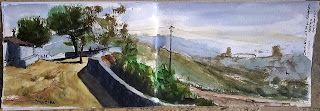Friday, February 22
Sunday, January 6
Sunday, May 7
Tuesday, November 8
Sunday, May 29
Saturday, May 28
Thursday, February 25
Wednesday, December 30
Friday, July 24
From time to time I do a large studio painting.
This one is based on preparatory charcoal drawing of the bulls and a small plein air oil painting (for the colors), and another charcoal drawing of the landscape at a specific time of the day (for the light), about 18:00 PM, summertime. I also used a photo of the mountain. The river and the clear water is from my imagination.
Lezíria de Vila Franca de Xira, Portugal.
Oil on canvas 120 x 80 cm.
This one is based on preparatory charcoal drawing of the bulls and a small plein air oil painting (for the colors), and another charcoal drawing of the landscape at a specific time of the day (for the light), about 18:00 PM, summertime. I also used a photo of the mountain. The river and the clear water is from my imagination.
Lezíria de Vila Franca de Xira, Portugal.
Oil on canvas 120 x 80 cm.
(clicking on image brings up larger view)
Wednesday, September 18
HOW TO LOOSEN UP YOUR PAINTING STYLE
 |
Watercolour by Helder Vieira |
Loose is how you want your picture to look, not a description of how you feel as you paint, as Andrew Pitt wisely concludes.
Here are the the words of Andrew Pitt, a wonderful artist that you can find in here:
HOW TO LOOSEN UP YOUR PAINTING STYLE
(Some Practical Tips)
One of the most frequently asked questions at art club demonstrations and on painting courses is: How can I loosen up? The commonly held view seems to be that a loose painting style is the result of a god given devil-may-care artistic temperament. But students who attempt to copy a loose painting style without understanding end up with a picture that looks self-indulgent and slapdash. What follows is a brief list of practical suggestions to help overcome this problem. The purpose of this list to provide a set of useful guidelines which are easy to understand and can be used to achieve what can seem to be a rather elusive painting style. A casual glance at the list will reveal that a loose painting style does not come about by adopting an uninhibited approach. Instead I believe that a degree of self restraint and thoughtfulness is more likely to be successful.
Before you start to paint try to visualize as much of your subject as you can as a simplified painted image.
Remember, loose does not mean slapdash or carelessness.
Use strong, distinct colour.
Remember you’re painting a watercolour. You want the end result to look like a watercolour, not a mud patch.
If painting in oil, remember you are representing the appearance of your subject with paint. Aim to get a painterly image by using a variety of paint textures.
Whatever you are painting aim to “touch” the paper only once with your brush. Try to get the finished result in one go. That is: Go for the final result in the beginning.
Avoid over-painting darks to make them darker. Get the darks first time.
When over-painting light passages take care not to disturb the first wash.
In watercolour, paint from light to dark. Paint from the outside edge to the inside of an area.
Paint from the background to the foreground.
Aim to get a variety of edges/boundaries.
Avoid correcting as you go along. In watercolour accidents are often the best bits.
When painting in oils go for the darks first. Keep the paint “thin” as long as you can. Don’t automatically use white to lighten tones – think colour.
If using oil, scrape down when correcting – don’t keep adding more and more paint.
All brush strokes should have a beginning and an end. Avoid dabbing. Use the belly of the brush.
Remember, when painting in watercolour, it is easier to add than subtract. Restrain yourself from mindlessly fiddling in the hope that more will improve your picture. Usually less is more.
Ask yourself, can I leave any areas unfinished? Better to promise more than to disappoint with your effort.
Stop painting when you find yourself starting to repaint areas.
Let the viewer see how you made your picture. But remember to preserve a bit of mystery as to how you achieved your effects. And if those last two statements seem contradictory, remember painting is full of paradoxes; don’t be frightened to break any so called rules.
Finally – loose is how you want your picture to look, not a description of how you feel as you paint.
Wednesday, January 30
Saturday, January 26
Saturday, January 19
Wednesday, January 2
Thursday, June 28
Thursday, May 10
Tuesday, May 8
Monday, May 7
Sunday, March 4
Subscribe to:
Comments (Atom)












































